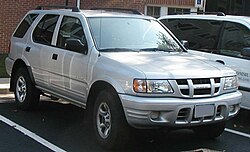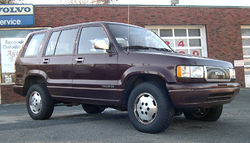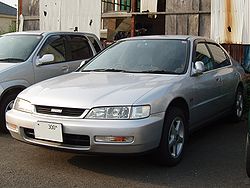| Generation 1 |
 |
| Also called | Opel/Vauxhall/Holden Frontera
Isuzu Rodeo
Honda Passport
Honda Jazz |
| Production | 1991–1997 |
| Engine(s) | 2.6L 120 hp (89 kW) I4
3.2L 175 hp (130 kW) V6 |
| Wheelbase | Rodeo: 108.7 in (2761 mm)
Amigo: 91.7 in (2329 mm) |
| Length | 1991-93 Rodeo: 176.4 in (4481 mm)
1991-92 Amigo: 164.2 in (4171 mm)
1991-92 Amigo XS 4WD: 168.1 in (4270 mm)
1993-94 Amigo: 165.5 in (4204 mm)
1993-94 Rodeo LS 4WD: 184.6 in (4689 mm)
1993-94 Rodeo: 183.9 in (4671 mm)
1996-97 Rodeo Base: 176.5 in (4483 mm)
1996-97 Rodeo S V6: 184.0 in (4674 mm)
1996-97 Rodeo LS: 184.6 in (4689 mm) |
| Width | Rodeo: 66.5 in (1689 mm)
Amigo: 70.1 in (1781 mm)
1994-97 Rodeo LS 4WD: 68.5 in (1740 mm) |
| Height | 1991-93 Rodeo: 65.4 in (1661 mm)
1991-93 Rodeo SX & 1996-97 Rodeo S: 66.5 in (1689 mm)
1991-92 Amigo: 65.2 in (1656 mm)
1991-92 Amigo XS: 65.7 in (1669 mm)
1993-94 Amigo: 69.9 in (1775 mm)
1994-95 Rodeo: 63.6 in (1615 mm)
1994-95 Rodeo LS 4WD: 64.4 in (1636 mm)
1996-97 Rodeo LS: 66.3 in (1684 mm) |
| Fuel capacity | 21.9 US gal. (82.9 L) |
| Related | JMC Landwind
Honda Passport |
| Generation 2 |
 |
| Also called | Opel/Vauxhall/Holden Frontera
Isuzu Rodeo
Honda Passport
Isuzu Rodeo Sport |
| Production | 1998–2004 |
| Engine(s) | 3.2L 205 hp (153 kW) V6 (Rodeo)
3.5L 250 hp (186 kW) V6 (Rodeo)
2.2L 130 hp (97 kW) I4 (Amigo/Rodeo Sport)
3.2L 205 hp (153 kW) V6 (Amigo/Rodeo Sport) |
| Wheelbase | Amigo/Rodeo Sport: 96.9 in (2461 mm)
Rodeo: 106.4 in (2703 mm) |
| Length | 1998-2000 Rodeo S & LS 2WD: 176.7 in (4488 mm)
1998-2000 LSE 4WD: 183.4 in (4658 mm)
1998-2000 Rodeo LSE 2WD: 176.4 in (4481 mm)
Amigo & Rodeo Sport: 170.3 in (4326 mm)
2001-02 LSE 4WD: 183.7 in (4666 mm)
2001-04 Rodeo: 177.5 in (4509 mm) |
| Width | 70.4 in (1788 mm) |
| Height | 1998-2000 Rodeo S: 66.1 in (1679 mm)
1998-2000 Rodeo LS & LSE 2WD: 68.5 in (1740 mm)
1998-2000 Rodeo LSE 4WD: 68.8 in (1748 mm)
Amigo & Rodeo Sport: 67.1 in (1704 mm)
2001-04 Rodeo: 69.4 in (1763 mm)
2001-04 Rodeo 2WD Base: 69.2 in (1758 mm) |
| Fuel capacity | 19.5 US gal. (73.8 L) (Rodeo)
17.7 gal. (67.0 L) (Amigo/Rodeo Sport) |
| Related | Isuzu Axiom
JMC Landwind
Honda Passport |
The Isuzu MU Wizard was a compact SUV made by Japan-based manufacturer Isuzu. The MU Wizard was introduced in 1990 as a 1991 model, and it ceased production in 2004. Isuzu manufactured several variations to the Wizard for sale in other countries. The United States has had two versions: the Isuzu Rodeo and (until 2002) the rebadged Honda Passport. Opel/Vauxhall and Holden each also sold rebadged versions of the vehicle.
Isuzu Rodeo
A version of the Wizard called the Isuzu Rodeo was manufactured at Subaru-Isuzu Automotive, Inc. (now, Subaru of Indiana Automotive, Inc.) in Lafayette, Indiana. Isuzu was rumored to prefer the "ro-DEE-o" pronunciation over "ro-DAY-o". The vehicle was still considered an import, as 75 percent of its parts were made overseas.
1991–1992
The Rodeo made its debut in 1991. The mid-size SUV was available with either a 2.6 L 4-cylinder engine or a 120 hp (90 kW), 3.1 L V6 made by General Motors. An automatic transmission was available for the latter.
The vehicle was available with four-wheel drive with manually locking hubs on the S version and automatically locking hubs on the XS and top-of-the-line LS. Rear anti-lock brakes were standard feature, but not an option for all four wheels.
All models had a rear seat bottom which folded forward and rear seat back which folded down; this vastly extending the 35 cubic foot (1.0 m³) cargo area. The vehicle's lug wrench was stored under the seat bottom, concealed by a carpeted Velcro flap. The jack was located behind a plastic panel in the left-rear of the cargo area along with the rear-windshield-washer fluid reservoir if so-equipped.
The LS was available with privacy glass, velour upholstery, and split-folding rear seats. The front door handles also had to be held aloft while closing the doors to lock.
A rear wheel drive, manual transmission model with a 21.9 U.S. gallon (83 L) tank was rated at 18 mpg (13.1 L/100 km) in city driving, 22 mpg (10.7 L/100 km) on the highway. A four wheel drive model with the V6 and automatic transmission was rated at 15 mpg (15.7 L/100 km) city and 18 mpg (13.1 L/100 km) highway, though these ratings were disputed by auto reviewers from the beginning.
A secret locking compartment was fitted in the depths of the center console below a removable cassette storage bin. Lack of cup holders was a common complaint of auto reviewers of the era.
The vehicle was 176.4" long and weighed 3,490 to 3,820 lb (1,580 to 1,730 kg), depending on engine and options.
Base prices (US)
- S — $12,818
- XS — $16,600
- LS — $17,899 for automatic, $16,799 for manual
Isuzu sold 24,612 Rodeos in 1991 and 45,257 Rodeos in 1992.
1993
For 1993, Isuzu replaced the General Motors V6 engine with their own 24-valve OHC V6 which was rated at 175 hp (130 kW). Manually-locking hubs were eliminated, but the floor-mounted transfer case shifter remained. The 1993 Rodeo featured a recalibrated suspension system, softened spring rates and softened shock valving.
The Rodeo now weighed between 3,536 and 4,120 lb (1,604 to 1,869 kg). Base price was raised to $14,074, and the EPA rating was 18 mpg (13.1 L/100 km) city and 21 mpg (11.2 L/100 km) highway.
Later models
In 1993, an Isuzu 3.2 L V6 engine became available, as well as a Family II 4-cylinder from Holden. And in 1996 Isuzu bumped the horsepower of their 3.2L V6 up to around 195 hp (145 kW) and 193 ft·lbf of torque for the 1996 and 1997 Rodeos.
In an interesting note, a song performed in 1997 by Collin Raye, "Little Red Rodeo", was about a man trying to find a former girlfriend that drove an Isuzu Rodeo.
The Isuzu Amigo, a slightly shorter, two-door version of the MU Wizard (Amigo) which was also available with a removable soft-top, was renamed Rodeo Sport before it was dropped from the product line.

Isuzu Amigo (US)

2004 Isuzu Rodeo
Isuzu Amigo
1990-1994
Introduced in the Spring of 1989 into the United States, this compact sport-utility really turned it’s focus on the sport rather than the utility end. The Amigo, as it was known in the US, came with both 2 wheel and 4 wheel drive models. A very small 96 hp (72 kW), 2.3 liter engine came standard with the 2wd and the 4 wheel drive came with the 2.6 liter cylinder motor. Both models came in only 5 speed manual transmissions except for the 1993 model. There were very limited options for the early Amigo including air conditioning, two seats or four and two trim models to choose from S or XS. Some of the changes throughout the years included, 1991- small cosmetic alterations to the 1990 model, 1992 4 speed automatic transmission was finally added; also the 2.3 liter motor was retired, all models came with the 2.6 standard, 1993 had no major changes, 1994, rear stop light was added, power steering was standard, power mirrors. Along with a limited number of XS-F editions ( "F" standing for "Frontera" ) this version had a few more toys such as power windows and locks 4 wheel ABS system although inactive in 4wd low range and only active on the rear wheels in 4wd-hi range. This version if the Amigo had only 49-state emissions (reasons unknown) There are no official sales numbers but most dealers agree there were less than 75 sold. The only bageing that shows this model is a sport blue XS symbol with a sport-font "F" beside it (also sport blue)
1998-2003
Outside- After making its US debut in 1991 and being dropped in 1994, the Amigo made a comeback in 1998 with a newly redefined model. The new Amigo shared the same body styling and sheet metal as the Rodeo, but with shorter wheel base and stiffer frame. Both models were built in the assembly plant in Lafayette, Indiana with the more modernized look. Amigo came standard with a soft top, similar to the Jeep Wrangler. Exterior differences in the Amigo and Rodeo other than the wheelbase includes a rear mounted spare tire, 16 inch tires, larger fender flares and the two door vs. Rodeo’s four door.
Inside- The Amigo shares the same interior as the Honda Passport. Standard features on the Amigo included split folding rear seats, tilt steering, dual power ports, power windows, mirrors and door locks, keyless entry and AM/FM CD players. The newer Amigo seats 5 however 4 people can ride comfortably.
On the Road – Amigo’s with the 2.2 liter, 130 hp (97 kW) are few and far between, mainly because previous owners complained to Isuzu that a v6 needed to be standard. Although a small SUV, it still packed a 4,250 pound weight, needing a lot of horsepower for everyday driving. Isuzu’s answer to this was the 3.2 liter, 205 hp (153 kW) v6 that carried 214-foot (65 m) pounds of torque at 3,000 rpm which is the same motor that the Rodeo carried. On the charts, the Amigo gives good torque to towing a 4,500 pound boat. Gas mileage on the Road is an estimated 22 MPG Highway.
From a technical prospective, the Amigo is built with a rigid frame that has 8 crossmembers. Front suspension has independent lower and upper arms, with a solid rear axle. Riding in the Amigo can feel much like a full size truck, feeling a lot of bumps in the road. All units came with Airbags and side impact door beams, as well as ABS.
Off the Road- the Amigo came standard with Isuzu’s 10 bolt rear axle, which in conjunction with its push button 4 wheel drive button, makes it a good SUV for slippery surfaces. Amigo also has a traditional floor mounted lever for switching from 4wd high to 4wd low. Taking the Amigo off road is acceptable, providing good four wheeling capability in small trails. For serious off road capability, Isuzu offered the Ironman Edition Amigo which came standard with a DANA 44 rear end, Intelligent Suspension control (ISC), limited-slip differential, larger tires that the LS model, and adjustable shocks for off road. These are the rarest of Amigos, Isuzu only producing about 288 in 2000, 187 in 2001. (Isuzu did produce Ironman Rodeos and Axioms during those years as well)
The Amigo was renamed in 2002 to the Rodeo Sport, to compliment its longer Brother the Rodeo. The Amigo series was produced until 2003 when the Rodeo and Rodeo Sport were dropped from Isuzu.
Frontera
The MU Wizard was known in the United Kingdom as the Vauxhall Frontera and in Europe as the Opel Frontera. It was originally built at the former Bedford Vehicles factory in Luton; it would become known as the IBC factory (Isuzu Bedford Company). In the 1980s the plant had come under joint control between Isuzu and General Motors, with the Frontera being built alongside a number of other commercial vehicle models. The Australian and New Zealand version of the MU Wizard model range was known as the Holden Frontera.
After General Motors took full control over the IBC Vehicles factory in 1998, the Frontera production line was transferred to General Motors' Vauxhall plant in Ellesmere Port, home of the Vauxhall Astra.
The Frontera was discontinued from production in 2004. If current rumours are correct, the replacement model in the Vauxhall range will be based on the hardware of the GM Daewoo/Chevrolet Captiva rather than an Isuzu model. In Australia and New Zealand, the Holden Frontera was replaced by a Holden badged version of the GM Daewoo/Chevrolet Captiva model range.



















![Validate my RSS feed [Valid RSS]](valid-rss-rogers.png)














































































